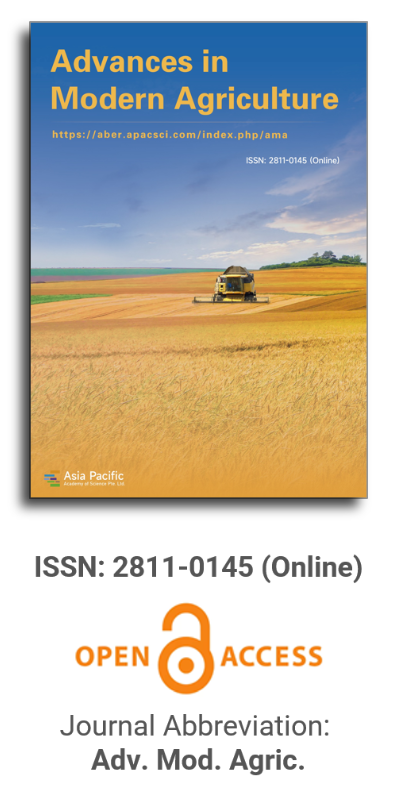


Application of plant indices (red band and near-infrared) in avocado plantations
Vol 3, Issue 2, 2022
VIEWS - 6853 (Abstract)
Download PDF
Abstract
Avocado is a traditional fruit in the diet of Ecuadorians and requires proper crop handling to guarantee high production. Implementations of new technological alternatives, such as spectroscopy indexes that correlate with each other, will optimize avocado crop management. This research validated the use of red band and near infrared-based plant indices with leaf nitrogen content. The plant indices used were normalized differential vegetation index (NDVI) and transformed vegetation index (TVI). These indexes were developed from two orthomosaics, obtaining images that capture red and near-infrared bands. Regression and correlation analysis were performed between the vegetable indices and the foliar nitrogen content analysis, generating R2 values of 0.93 for NDVI, and 0.95 for TVI. The values of the plant indexes can be used to estimate plant vigor based on the nitrogen content of the foliar area.
Keywords
References
- Sotomayor A, Viera A, Viera W. Potential of avocado cultivation (Persea Americana mill) in Ecuador as a marketing alternative in the local and international market (Spanish). UPSE Scientific and Technological Magazine 2016; 3(3): 1–9. doi: 10.26423/rctu.v3i3.192
- National Institute of Statistics and Censuses. Continuous Agricultural Area and Production Survey-2018 (Spanish). Available online: https://www.ecuadorencifras.gob.ec/encuesta-de-superficie-y-produccion-agropecuaria-continua-2018/ (accessed on 20 June 2022).
- National Institute of Statistics and Censuses. Continuous Agricultural Area and Production Survey-2019 (Spanish). Available online: https://www.ecuadorencifras.gob.ec/encuesta-de-superficie-y-produccion-agropecuaria-continua-2019/ (accessed on 20 June 2022).
- Meneses VB, Velásquez DÁ, Téllez JM. Optimization system for planning techniques in precision agriculture using drones (Spanish). Environmental Journal Water, Air and Soil 2016; 7(2).
- López-Aguilar HA, García-Pérez JL, Barrientos-Juárez E, et al. Non-destructive method to evaluate plant vigor in forest species grown in nurseries (Spanish). International System of Agronomy 2016.
- Gaona, Pablo, Vásquez, Laura, Viera, William, et al. Effect of two levels of nitrogen and potassium applied by fertigation on the growth variables and concentration of macro and micronutrients in avocado plants (Persea Americana mill.) var. Hass (Spanish). Revista Científica Ecuatoriana 2020; 7(2). doi: 10.36331/revista.v7i2.114
- Viera W, Cartagena Y, Toaquiza J, et al. Response of ‘Hass’ avocado under different nitrogen and potassium fertilizer regimes in subtropical Ecuador. Acta Horticulturae 2021; 1327: 175–180. doi: 10.17660/actahortic.2021.1327.23
- Zheng H, Cheng T, Li D, et al. Evaluation of RGB, color-infrared and multispectral images acquired from unmanned aerial systems for the estimation of nitrogen accumulation in rice. Remote Sensing 2018; 10(6): 824. doi: 10.3390/rs10060824
- Vilanova de la Torre MM, Pérez R, Cancela Barrio JJ, et al. Use of multispectral images to determine the aromatic quality of cv. Mencia (Spanish). In: Proceedings of III National Symposium of Horticultural Engineering; 21–23 February 2018; Lugo, Spain.
- Martínez JM, Mendoza España MC. Balance and perspectives of the use of remote sensing for the study of water resources in the TDPS system (Spanish). In: Pouilly M, Lazzaro X, Point D, Aguirre M (editors). Knowledge Base Line on Hydrological and Hydrobiological Resources in the TDPS System with a Focus on the Lake Titicaca Basin (Spanish). IRD; 2014. pp. 81–95.
- Campos León MB, Calderón Zaragoza EM. Leaf Analysis for Nutritional Diagnosis of Avocado Plantations. Tabking Samples (Spanish). Agricultural and Fisheries Research and Training Institute; 2015.
- Meneses Tovar CL. The normalized differential vegetation index as an indicator of forest degradation (Spanish). Available online: https://www.fao.org/3/i2560s/i2560s07.pdf (accessed on 20 June 2022).
- Piscoya Pérez LR. Normalized difference vegetation index (NDVI) in the district of Puquina, Moquegua. Available online: http://repositorio.untels.edu.pe/jspui/handle/123456789/144 (accessed on 20 June 2022).
- Escobar Pardo O. Spectral Responses to Nitrogen and Potassium Fertilization in Banana Cultivation (musa aaa simmonds), Case of the Banana Zone Municipality (Spanish) [Master’s thesis]. Universidad Nacional de Colombia; 2015.
- Crusiol LGT, de Carvalho JFC, Sibaldelli RNR, et al. NDVI variation according to the time of measurement, sampling size, positioning of sensor and water regime in different soybean cultivars. Precision Agriculture 2016; 18(4): 470–490. doi: 10.1007/s11119-016-9465-6
- Juzga Solanilla M. Comparison of Vegetation Indices in the Cerro de la Conejera in the City of Bogotá. Nueva Granada Military University; 2016.
- Pat López ER. Nutritional Levels, Color and Spectral Reflectance of Tree Leaves in Avocado (Persea Americana) Orchards in Michoacán (Spanish) [PhD thesis]. Universidad de Quintana Roo; 2015.
- Mendez-Garcia T, Palacios-Mayorga S, Rodriguez-Dominguez L. Soil, foliar and water quality analysis for avocado cultivation (Spanish). Latin American Earth 2008; 26(1): 75–84.
- Sotelo-Nava H, Hernandez-Castro E, Villegas-Torres OG, et al. Nutritional diagnosis of “Hass” avocado (Persian American Mill.) soil fertility and water quality, in Tepoztlán, Morelos (Spanish). International Journal of Environmental & Agricultural Research 2017; 3(1): 152–159.
- Zenteno Cruz GA, Palacios Vélez E, Tijerina Chávez L, et al. Application of remote sensing technologies for the estimation of sugarcane yield (Spanish). Mexican Journal of Agricultural Sciences 2017; 8(7): 1575–1586. doi: 10.29312/remexca.v8i7.513
- Sanjerehei MM. Assessment of spectral vegetation indices for estimating vegetation cover in arid and semiarid shrublands. Range Management and Agroforestry 2014; 35(1): 91–100.
- Cabrera-Bosquet L, Molero G, Stellacci A, et al. NDVI as a potential tool for predicting biomass, plant nitrogen content and growth in wheat genotypes subjected to different water and nitrogen conditions. Cereal Research Communications 2011; 39(1): 147–159. doi: 10.1556/crc.39.2011.1.15
- Vian AL, Bredemeier C, Turra MA, et al. Nitrogen management in wheat based on the normalized difference vegetation index (NDVI). Ciência Rural 2018; 48(9). doi: 10.1590/0103-8478cr20170743
- Maresma Á, Ariza M, Martínez E, et al. Analysis of vegetation indices to determine nitrogen application and yield prediction in maize (Zea mays L.) from a standard UAV service. Remote Sensing 2016; 8(12): 973. doi: 10.3390/rs8120973
- Hashemi SA, Fallah Chai MM, Bayat S. An analysis of vegetation indices in relation to tree species diversity using by satellite data in the northern forests of Iran. Arabian Journal of Geosciences 2012; 6(9): 3363–3369. doi: 10.1007/s12517-012-0576-8
- Casassa Bastres DA. Relationship between NDVI and nitrogen content in a forage corn crop in the Valdivia agroecosystem (Spanish). Available online: http://cybertesis.uach.cl/tesis/uach/2019/fac335r/doc/fac335r.pdf (accessed on 20 June 2022).
- Smith HL, McAusland L, Murchie EH. Don’t ignore the green light: exploring diverse roles in plant processes. Journal of Experimental Botany 2017; 68(9): 2099–2110. doi: 10.1093/jxb/erx098
- Ramos García CA. Method to Estimate the Nitrogen Content in Corn Crops (Zea mays L.) Based on Spectrometry. Case Study Puerto Gaitán, Meta (Spanish) [Master’s thesis]. Universidad Nacional de Colombia; 2015.
- Hunt ER, Doraiswamy PC, McMurtrey JE, et al. A visible band index for remote sensing leaf chlorophyll content at the canopy scale. International Journal of Applied Earth Observation and Geoinformation 2013; 21: 103–112. doi: 10.1016/j.jag.2012.07.020
- Prabhakara K, Hively WD, McCarty GW. Evaluating the relationship between biomass, percent groundcover and remote sensing indices across six winter cover crop fields in Maryland, United States. International Journal of Applied Earth Observation and Geoinformation 2015; 39: 88–102. doi: 10.1016/j.jag.2015.03.002
- Rendón JR, Sadeghian S. Application of spectral indices to identify nitrogen fertilization needs in coffee (Spanish). Cenicafé Magazine 2018; 69(1): 7–15. doi: 10.38141/10778/1088
Supporting Agencies
Copyright (c) 2022 Anderson Mauricio Guerrón Barahona, William Fernando Viera Arroyo, Diego Fabricio Campaña Cruz, Laura Viviana Vásquez Rojas, Carlos Lenin Montufar Delgado

This work is licensed under a Creative Commons Attribution 4.0 International License.

This site is licensed under a Creative Commons Attribution 4.0 International License (CC BY 4.0).

Prof. Zhengjun Qiu
Zhejiang University, China

Cheng Sun
Academician of World Academy of Productivity Science; Executive Chairman, World Confederation of Productivity Science China Chapter, China
Indexing & Archiving
In the realm of modern agriculture, the integration of cutting-edge technologies is revolutionizing the way we approach sustainable farming practices. A recent study published in Advances in Modern Agriculture titled "Classification of cotton water stress using convolutional neural networks and UAV-based RGB imagery" has garnered significant attention for its innovative approach to precision irrigation management. Conducted by researchers from Institute of Data Science and the AgriLife Research and Extension Center of Texas A&M University (authors's information is below). This study introduces a novel method for classifying cotton water stress using unmanned aerial vehicles (UAVs) and convolutional neural networks (CNNs), offering a powerful solution for optimizing water use in agriculture.
Modern agricultural technology is evolving rapidly, with scientists collaborating with leading agricultural enterprises to develop intelligent management practices. These practices utilize advanced systems that provide tailored fertilization and treatment options for large-scale land management.
This journal values human initiative and intelligence, and the employment of AI technologies to write papers that replace the human mind is expressly prohibited. When there is a suspicious submission that uses AI tools to quickly piece together and generate research results, the editorial board of the journal will reject the article, and all journals under the publisher's umbrella will prohibit all authors from submitting their articles.
Readers and authors are asked to exercise caution and strictly adhere to the journal's policy regarding the usage of Artificial Intelligence Generated Content (AIGC) tools.
Asia Pacific Academy of Science Pte. Ltd. (APACSCI) specializes in international journal publishing. APACSCI adopts the open access publishing model and provides an important communication bridge for academic groups whose interest fields include engineering, technology, medicine, computer, mathematics, agriculture and forestry, and environment.



.jpg)
.jpg)

.jpg)
